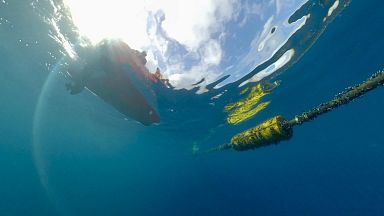Leaders in the renewable energy sector tell Euronews Correspondent Denis Loctier how Europe can make better use of its surrounding waters to generate a reliable and sustainable source of electricity.
The world's oceans, covering approximately 70 per cent of the planet's surface, are, for the most part, an untapped energy source. However, Wavepiston, a global leader in wave energy solutions, wants to change all that by harnessing the power of the ocean.
The Danish company has created high-power water pipes with the support of the European Union. The natural movement of the waves generates clean energy with the help of underwater plates and a turbine.
The device is currently undergoing a year-long test off the coast of Gran Canaria in the Atlantic Ocean. The method is intentionally simple but effective, cutting down on costly offshore repairs. The seawater, once pumped to land, serves two purposes; it can be used to generate clean energy or desalinated to create fresh water.
Michael Henriksen, the CEO and founder of Wavepiston told Euronews that it is important to have these pipes relatively close to the shore to make energy conversion easier. Unlike wind turbines, which some argue are unsightly and obstruct areas of natural beauty, these pipes are underwater and therefore don't obstruct the view.
The energy converters and desalination components are located at an offshore research facility called the PLOCAN platform. Here, Wavepiston has access to a power grid and a wide range of tools. The company uses plates made of polypropylene, a material that can bend without snapping and withstand stormy conditions without breaking down.
A French solution
Nestled high in the French Alps, near the city of Grenoble, HydroQuest, a company which uses tidal streams to generate electricity, is planning to build the world's most powerful tidal farm.
"We can accurately model the movements of the moon and gravitational effects through the deformation of the tides. So we know exactly what's happening, provided we understand the area and the shape of the seabed. We can predict, decades in advance, the speeds we'll have at the site, and therefore the consequent electricity production" said Thomas Jaquier, the president of HydroQuest.
HydroQuest recently demonstrated its technology in an EU-funded project named TIGER and showcased how the technology can be used to maximise tidal streams in and around the English Channel.
"The pilot farm is a 17.5-megawatt project with seven machines that have been installed in a line in the middle of Alderney Race. The electricity production will be 41 gigawatt-hours per year. That's enough to power about 20,000 consumers (or 8,000 households)" added Jaquier.
Generating power in Portugal
The powerful ocean waves and tides along Europe's Atlantic and North Sea coasts are helping European innovators transition to cleaner, local energy sources.
Changes are already visible in some industrial ports that are making room for more marine energy projects. Over 120 groups in this growing field are represented by Ocean Energy Europe, the largest global network of ocean energy professionals.
“Europe has one of the largest coastlines in the world. We've identified that wave and tidal together can produce about ten per cent of current electricity consumption, which might sound small, but that's exactly what today's hydropower solutions, the big dams on all of the rivers in Europe, are producing” said Rémi Gruet, the CEO of the organisation.
A few tidal farms are already up and running as well as the first commercial-scale wave energy converters. One such model was developed by CorPower, a leader in wave energy technology. It can withstand fierce storms at an offshore test site in Portugal while keeping costs manageable.
The device uses fibreglass buoys to generate energy from the waves and is another example of how the EU can create a sustainable power supply for a greener future.
For Denis's full report, click on the video in the media player at the top of the page.













